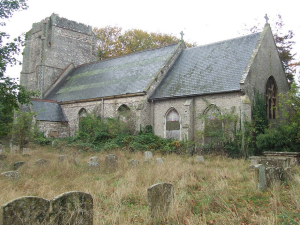 Dr Jennifer Freeman explored the conversion of the Grade II* Church of St Mary the Less, Thetford, Norfolk, including the challenges buildings on the Heritage at Risk Register, retrofitting, and maintaining the churchyard as an open space, in a text abbreviated in the Historic Environment Forum’s (HEF) ‘Heritage Responds’ [download] COP26 publication.
Dr Jennifer Freeman explored the conversion of the Grade II* Church of St Mary the Less, Thetford, Norfolk, including the challenges buildings on the Heritage at Risk Register, retrofitting, and maintaining the churchyard as an open space, in a text abbreviated in the Historic Environment Forum’s (HEF) ‘Heritage Responds’ [download] COP26 publication.
image: for illustration purposes only – Keith Evans / St. Mary The Less Thetford https://upload.wikimedia.org/wikipedia/commons/d/d3/St._Mary_The_Less_Thetford_-_geograph.org.uk_-_1552814.jpg
… Grant support of £410,000…. by Historic England….Breckland Council was hugely supportive…
The Historic Church of St Mary the Less,Thetford, Norfolk, Grade II*
My small property company, Freeman Historic Properties Ltd (FHP), specialises in repairing and regenerating highly graded listed buildings in gross disrepair — those which are seriously at risk of loss.
Happily, Historic England (HE) keeps track of listed buildings ‘at risk’ and produces an annual review. Every year a commendable number of threatened buildings are rescued and regenerated for suitable new or pre-existing uses by building preservation trusts, individuals and other organisations.
But many buildings linger on the lists for years, sadly deteriorating, especially when their rescue is dependent on large grants from limited HE funds (Lottery funding being available only to eligible applicants such as charities). Long gone are the days of even modest financial support from local authorities. Discouragingly, VAT is unfairly levied on repair programmes yet not on building new structures. Why the anomaly, we ask?
Historic structures were for the most part soundly built, in addition to embodying great architectural, historic and archaeological interest where listing applies. The structures retain the investment of building materials and energies of the past and are nearly always capable of repair and/or repurposing for worthwhile uses. Compared with the usually shorter life cycle of modern buildings they offer better long term value. By way of shocking example, it is anticipated that over 500,000 houses built since 2017 will require retrofitting to cope with warming temperatures and future heatwaves, reported the UK Government’s Climate Change Committee in July. Older properties fair better, being less susceptible to huge temperature swings. These, and other positive factors should be taken into account when resources are allocated.
Furthermore, repair works to older buildings can often be achieved with lower energy input, by re-using building materials and sourcing new materials locally. Less power is required. The result is less upheaval, less polluting noise and dust and, overall, a ‘greener’ project. Increasingly new research confirms this view but the culture and the ‘philosophy’ needs to spread. It is a win-win process all round. The Tower of St Mary the Less in Thetford now, for example, has a fresh input of locally sourced durable flint stone. The approach should be more widely recognised and applied to projects that do not necessarily involve listed buildings, simply older buildings of interest. Mending, not replacing the built environment should be the watchword.
The thinking can be applied to the green environment too. For example, a few years ago I noticed about twenty trees being felled in an office redevelopment site in the East End of London. They were healthy trees, just reaching their maturity and obviously freshly planted by developers of the previous building then under demolition. I asked the new developer why he could not build around them. The reply came that the trees would be replaced. Eventually, a few small young trees appeared. But in a relatively treeless area the health benefits of many mature trees were lost for years. We should take a more inclusive view of the assets on any building development site. At St Mary the Less magnificent TPO’d trees have been carefully trimmed and many small shrubs are being retained in the churchyard.
The repair of grade II* St Mary the Less Church, after it had been acquired by FHP Ltd in 2014, proved highly complex and more expensive than anticipated. Fifty years of disrepair had taken their toll. The Tower had been fire-damaged and vandalised during the long period of disuse. As Chair of FHP I felt, with my experience of some 30 repair/restoration projects and with qualifications in architectural history and building conservation, I might make a success of a conversion scheme to much-needed housing. My chosen architectural practice was Caroe Architecture which has extensive experience of repairing historic churches and regeneration projects. Grant support of £410,000 was made available by Historic England that had despaired of finding a saviour for the church. Breckland Council was hugely supportive, but sadly, had no funding. No-one objected to my scheme. Support was widespread. The Society for the Protection of Ancient Buildings used the church as an exemplar of good practice in building repair for its architect-students. Some VAT was usefully refunded because a housing scheme was always planned. FHP contributed funding of its own.
Yet none of the team on site could have been aware of the extent of disrepair to the Tower until the scaffolding went up and deep investigations of the corner buttresses began in earnest. Even with the generous grant from HE it was obvious that FHP’s budget would not extend to the conversion of the whole church into five houses, though the principle was agreed by HE and Breckland Council. I had to think again. Uncertainty so often accompanies forays into the field of ‘at risk’ buildings . Careful financial planning for a range of eventualities is required. The church is thus shortly to be put on the market for conversion to the five houses originally envisaged, one in the repaired mediaeval tower, one in the chancel and three towards the northern side, leaving the famous Fulmerston monument in the future ‘common parts’ on the nave wall to the south. Great interest is, happily for FHP Ltd, being shown.
No new-build is being introduced into the lovely and historic churchyard which, together with the church, stands in a designated Conservation Area. In addition to the magnificent trees, a fascinating range of monuments, some of which are listed inside the church and outside, are being retained. Recovered sound timbers and stonework are being held in the church for possible re-instatement in the houses or the churchyard for outdoor seating or other uses. Sadly few interior features remained except for the grand Fulmerston monument and interesting wall tablets, following years of vandalism.
The project is proving popular in Thetford. My sadness remains that the dire condition of the Tower forbade further works owing to cost. I am grateful to my professional team, whose (all too rare) skills I highly recommend. We need more training programmes to provide the craftspeople of the future and more grant aid from varied sources for sensitive repair projects in order to put right past disrepair. The problem was highlighted in a recent report by Historic England announcing additional funding for building craft skills in short supply, such as flintknapping and pargeting, with grant support from the Hamish Ogston Foundation. This is a welcome positive step.
My proposals for St Mary the Less will provide much needed housing, with major structural repairs not envisaged to be required for some 50 years. When servicing is introduced, it will be good to instal ground-source heating and solar panels (hidden from view) to ensure efficient energy consumption and sustainability. A building that dates probably from before the Norman Conquest will get its chance again for years of beneficial use. I do not doubt that a sympathetic developer will shortly emerge to tackle the final pert of the conversion scheme but I am astonished by the extent of fear and sheer ignorance that surrounds works to historic structures shown by those who should know better, and at least be able to indicate where to get good advice. Such advice is willingly delivered by Historic England, architects and others accredited in building conservation.
One may also regret the failures in the past of redundancy procedures for churches not taken into care by the Churches Conservation Trust such as St Mary the Less. Tighter surveillance has indeed followed in recent years but problems remain. A salutary comment came from a solicitor who knew about the acquisition of St Mary the Less: ‘I never encourage clients to take on a listed building’. This woeful lack of knowledge, support, information and genuine fear clearly holds back many a promising regeneration scheme and harms the prospects for worthwhile endeavours and historic structures in need. Lack of information and the confidence to bring schemes to fruition holds back progress in the UK which, owing to fewer wars at home, enjoys a huge legacy of historic structures.
Thetford needs regeneration – as do many small towns – yet there is much local pride in its long history and historic fabric. I would like to feel FHP has saved a portion of that for future generations in a sensitive, cost-effective way that will stand the test of time.
Dr Jennifer M. Freeman OBE HonDoctArts IHBC BAHons GradDiplCons(AA) FSA FRSA
Bibliography
Jenny Freeman, Roy Tricker, Oliver Caroe; The Historic Church of St Mary the Less, Thetford, Norfolk, Freeman Historic Properties Ltd, July 2021
Jessica Hope, Filling In the Retrofit Gaps, Historic England,2021
James Hughes, Ecclesiastical Exemption,Is It Working? The Victorian, July 2021
Douglas Kent et al, Windows and Doors, SPAB Briefing Note, 2016
Alice Yates, Reflections on a Resilient Heritage Project, Context, March 2021

Why is IHBC@COP26? Because ‘Conserving our Places Conserves our Planet’
See more background at IHBC’s globally accessible virtual built and historic environment ‘Conservation Helpdesk+’, #IHBCHelpdesk #CultureCOP26
Listen the IHBC@COP26 ‘Climate and Conservation’ Podcasts anytime, or from the ‘Conservation Helpdesk+’

